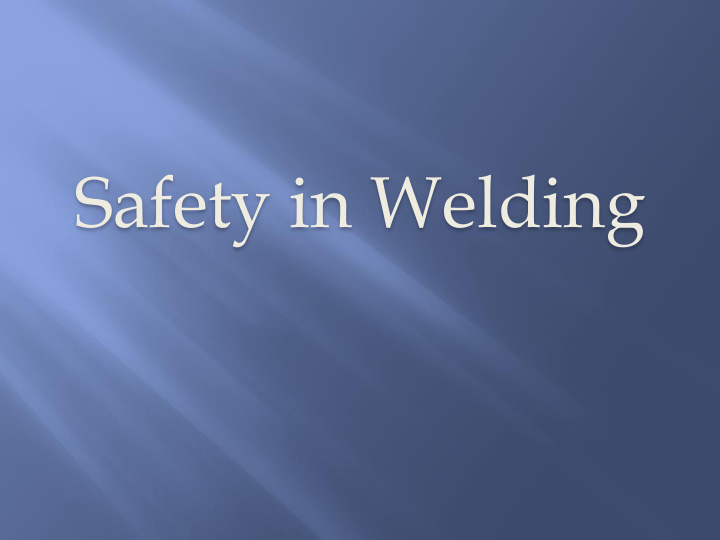



Safety in Welding
Welding Safety No substitute for caution and common sense o Each person must take personal responsibility • Their own safety and safety of others on the job • A number of potential safety hazards Learning to work safely o As important as learning to be a skilled welding fabrication worker
Guidelines Shirts must be long-sleeved Pants must be long enough to cover the tops of the boots and must be without cuffs Boots must have high tops Caps should be thick Clothing must be free of frayed edges or holes Some clothes have pockets Not safe to carry a butane lighter or matches while welding
Gloves — Wear heavy leather gloves with gauntlets
Welding cap — Wear a cap with a flexible bill that can be slipped around to cover either ear to keep sparks and metal splatter out of the ear opening.
Shirts — Wear heavy, long-sleeved shirts with pocket flaps; remove pockets or tape them shut if they do not have pocket flaps; keep collar and sleeves buttoned to keep out sparks.
Pants — Wear pants that have no cuffs and are long enough to cover the top of your shoes or boots. No fray jeans or shorts
Extra protection is needed for each person who is in direct contact with hot materials Hand protection Body protection Waist and lap protection Arm protection Leg and foot protection
Eye protection Must be worn in the shop at all times Safety glasses with side shields Goggles Full face shield Flash glasses
Safety glasses with side shields Adequate for general use Not suitable for heavy grinding, chipping, or overhead work Must be worn under an arc welding helmet at all times
Even with quality welding helmets, the welder must check for potential problems Undetectable leaks of ultraviolet light can cause a welder's eyes to itch or feel sore Ensure lens gasket is installed correctly Tape can be used as a temporary repair
Undetectable leaks Proper welding helmet
Welding environment can be very noisy Hot sparks can drop into an open ear and cause severe burns Several forms of protection Earmuffs cover the outer ear completely Earplugs fit into the ear canal
Welding area should be well ventilated Natural ventilation is best Forced ventilation may be required Large enough areas may not require forced ventilation
Burns One of the most common and painful injuries Caused by ultraviolet light rays or contact with hot welding torches Chance of infection is high All burns must receive proper medical treatment Divided into three classifications First-degree, second-degree, and third-degree
Some types of light can cause burns Ultraviolet Infrared Visible Arc welding produces all three types of light Gas welding produces visible and infrared light only Light from the welding process Can be reflected from walls, ceilings, floors, etc.
Long sleeves and gauntlet welding gloves. Cutting goggles with shade 5 lens. Use proper friction lighter to light gas.
https://www.youtube.com/watch?v=ejEJGNL To84
Types of Welding Hazards Fires and explosions Do not carry any cigarette lighters in the • welding lab. Do the following to protect from fire and • explosions: Always know where the fire exits and fire • extinguishers are located. If welding within 35 feet of a combustible • object, utilize a fire watcher, who can watch for landing sparks.
Four types Type A: combustible solids Type B: combustible liquids Type C: electrical fires Type D: combustible metals Location Appropriate type should be located near types of combustible materials it is used for
Proper PPE Required Correct Polarity Turn off when not in use Check Welding Hood
Insure Insulators are not broken. Check cables for breaks in insulation. Once electrode is placed in holder end of electrode is live.
Always stop and do an inspection of the grinder before first use. Safety glasses, face shield, gloves.
Do not grind out in the center of the lab for any reason! Grind in booth with curtain closed. Grind in grinding room.
Fasten all loose clothing Tuck in shirt tails Remove strings from sweat shirts or jackets. Take special care to keep clothing, other cords, clear. Do not use flat, buff on edge or slight angle.
Release trigger and hold blade on base material until the blade stops!
Considerations Work area: should be picked up and swept clean Arc welding areas: painted with a flat dark color Portable screens: used if welding outside the welding booth Piece of hot material is left unattended: write hot on it before leaving
Used for assembly and disassembly of parts Adjustable wrench is the most popular Fewer points a box end wrench or socket has: the stronger it is Mushroomed heads of chisels, punches, and the faces of hammers should be ground off Always use the correct tool for the job
Considerations Hand tools should be treated properly and not abused Keep hand tools clean Make sure that hand tools are sharp Protect cutting edges when carrying Keep hammer handles secure and safe When swinging a hammer, be absolutely certain that no one is within range
Eye Protection Use tongs & gently submerge weldments Protect others from HOT steel
HAND WASH EYE WASH FIRST AIDE HAND SOAP DRINKING FOUNTAIN
Safety is of the utmost importance The Instructor ensures welders comply with safety rules Wear proper clothing, shoes, and protection Have established procedures in case of accidents Check equipment periodically
Recommend
More recommend